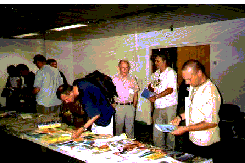D
X
P

By Chris Gill
Summary of lecture given at the conference of the National Association of Shortwave Broadcasters, USA, November 2000
Published in the Electronic DX Press
Considerable uncertainty exists as to
which emerging technologies are likely to succeed for a sustained
period. We can be certain of some things as regards the future
of broadcasting: the choice of new technologies will be even greater
in the future than it is today; in most markets, the listener
will be increasingly tempted by improved audio quality; however
good the content, the listener will also be looking for choice;
of all the new technologies offered, some will not succeed. The
challenge facing international broadcasters is making the right
choice. In the past, it was possible to compete (mostly with mediumwave
and shortwave) on the basis of the quality of the content of a
broadcast, with audio quality being a secondary issue. In the
future, expectations will be for a higher level of audio quality.
With the proliferation of outlets for programs such as FM, cable,
the Internet, and satellite, we must form a reasonably accurate
view of how our listeners will access our "content"
in the future. Many believe that satellite and the Internet will
be the major "content" providers of the future. With
the wide choice of "content" available, broadcasting
is moving more and more into narrowcasting, with content tailored
to specific interests. The Internet, in particular, offers the
possibility for self-assembled, on-demand personalised content.
However, radio will continue to be a significant means of getting
audio to the listener for many years to come. However much the
choices may expand, whatever the range of new technologies available,
there will still be many occasions during the day when we can't
look at a screen, or sit down at the computer, or use the Internet
types of technology. Radio still fills an important gap.
Mike Cronk (of the BBC and DRM) suggests that radio of the future
should meet these criteria: easy operation for the listener; simple
designations for different "channels"; possess good
audio quality with good dynamic range; economical transmission
requirement; the signal must cover a large land mass without reception
being hampered by obstructions such as hills or buildings; fading
and interference must be minimised; broadcasters should be able
to control the "gateway"; maximise use of previous investments
and minimise costs of required new investments; receivers shouldn't
be much more expensive than present receivers; must be workable
within present spectrum allocations.
In March 1998, a group of broadcasters, transmitter and receiver
manufacturers, network operators, and research bodies signed a
"Memorandum of Understanding" to develop a system with
characteristics as described above. Later that year a formal consortium
agreement was completed, putting in place a body committed to
the development of a digital standard for the AM bands below 30
MHz. Digital Radio Mondiale (DRM) was established.
The DRM Technical Committee, working in a very tight time frame,
developed a standard sufficiently robust to submit to the ITU.
Also, they conducted a series of propagation tests using five
converted transmitters around the world. These tests were for
the purpose of proving that the theory would work out in practice.
In future months, the DRM will be encouraging adoption of the
proposed standard, as well as continuing the more detailed development
work, and testing the system.
Estimates from the transmitter industry indicate that modern transmitters
could be converted to digital at a cost of about $100,000 per
transmitter.
They aim to have digital receivers in the marketplace in late
2001 or early 2002. One of DRM's goals is that a receiver bought
anywhere in the world will work anywhere in the world. For this
to succeed, it is important that a standard emerges from the work
of the ITU that meets the needs of the broadcasting industry around
the world. As a result, DRM has started to work with USADR to
promote the adoption of a global standard. This will reduce the
cost of new receivers and make the product more attractive to
the consumer.
Gill's research indicates that there are an estimated 2.5 billion
receivers in the world, of which 60% are estimated to have shortwave
on them. In the ITU listings, there are 169 organisations using
HF on a wide scale, broadcasting from 593 locations around the
world.
Although it may not be possible to arrive at a single world-wide
standard for digital broadcasting, it is hoped that there will
be sufficient coordination that a single receiver will be capable
of receiving any of the systems that get into actual use.
One very possible development of the near future is a single portable
device that will provide music, news, commentary, e-mail, web-access,
video, and such, all via digital transmission. If broadcasters
are not fully on digital platforms, they may not be part of this
delivery system. DRM is an opportunity for broadcasters to achieve
that digital presence.
NASB
members are: Adventist
World Radio, Assemblies of Yahweh,, Family Radio Network, Far
East Broadcasting Company, Herald Broadcasting Syndicate, High
Adventure Ministries, LeSea Broadcasting Corporation, Radio Miami
International, Trans World Radio, World Christian Broadcasting,
World Wide Catholic Radio
NASB Associate Members are: Antenna Products, Continental
Electronics, Corporation, George Jacobs and Associates, HCJB World
Radio, IBB Technology for Communications Int., Thomcast, Inc.